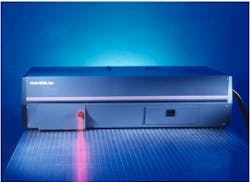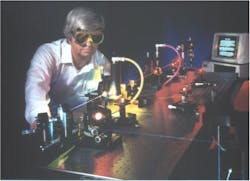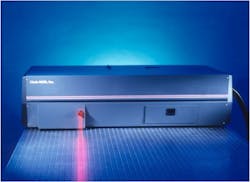Ultrashort pulse laser micromachining: History and future opportunities
Tissa Gunaratne, Ph.D., director, sales and marketing for Clark-MXR, interviews Bill Clark, Ph.D., a founder and CEO of Clark-MXR and an industry pioneer in ultrashort pulse laser micromachining.
Tissa Gunaratne: How did you get started in this field of ultrashort pulse lasers when the femtosecond laser was a solution looking for a problem?
Bill Clark: In the early '80s, I worked for Spectra-Physics as a sales engineer covering Bell Labs. My customers taught me a lot about femtosecond pulses of light and their potential. Several scientists at Bell Labs were building colliding pulse modelocked dye lasers (CPMs) out of components bought from companies like Newport. At the time, our young children were into Lego kits. It seemed obvious to offer a similar kit on how to build a CPM with Newport components. (“The only difference between men and boys is the price of their toys.”) So, I moved to Newport. Frank Wise, then a graduate student in C.L.Tang’s group at Cornell University, and I designed the first commercial CPM Lego-type kit for customers who wanted to build their own femtosecond laser (Figure 1).
TG: Was it a hard decision to start a company selling ultrafast lasers when lasers were only part of elite research laboratories?
BC: It was more scary than hard. Our family of five had just moved into a new house while I was at Newport. I was weighed down by those obligations. Milton Chang, then the president of Newport, made it easy for me. As part of my exit package, he gave me all the work that went into the development of the CPM. He also included a sub-contract to build one for a customer who had placed an order with Newport. My wife and I figured we could survive for a year. And with her support and encouragement, we started Clark Instrumentation in our basement.
TG: How did you step into ultrashort pulse micromachining and what influences made you go in this direction?
BC: Dr. Gerard Mourou, then a professor at the University of Michigan and a founder of the MXR portion of what became Clark-MXR in 1992, was the first to recognize that femtosecond pulses of light ablated material in a more deterministic manner and with less heat-affected zone (HAZ) than longer laser pulses. (Gerard’s group had also invented the concept of chirped pulse amplification, a critical development in the production of the peak power needed to ablate materials with ultrashort pulses of light.) In several of our monthly stockholders' meetings, Gerard expressed his conviction that femtosecond laser micromachining would be important in the future. His prodding inspired us to look for ways to repackage what was then a system that occupied an entire optical table (Figure 2).
The result was the Model CPA-2000 Series with a footprint one-fifth the size of earlier versions (Figure 3). This was the first one-box CPA specifically designed for micromachining that could operate in an industrial environment. See https://www.youtube.com/watch?v=1gz1jb74VI8; that architecture was a decade ahead of its time.
About the same time, Dr. Hans-Erik Swoboda, our agent in Europe, was collaborating with Dr. Arnd Menschig, then at DLR in Stuttgart. Arnd was using one of our earlier CPA lasers to micromachine materials. Erik and Arnd put together the first active demonstration of femtosecond laser micromachining at the LASERS Munich Exhibit in 1997.
TG: What were the power centers for ultrashort pulse micromachining, meaning the ringleaders, locations, and their influence on you?
BC: Mourou, Philippe Bado at MXR, Inc., Andreas Ostendorf at LZH in Germany, Barry Luther-Davies at the Laser Physics Center, Australian National University, Erik Ippen at MIT, and of course Frank Wise at Cornell University—to name but a few. All of them shared and reinforced my belief in the potential of this new, neat technology. Developing one’s ideas, receiving respected professional endorsement, and therefore being able to make a living doing something you love is one of life’s greatest rewards.
TG: Tell us briefly, what is fundamentally different in ultrashort pulse micromachining compared to other laser micromachining techniques?
BC: To remove atoms from a solid, it is necessary to overcome the forces that bind those atoms to the material. At pulse intensities greater than 10+13W/cm2, the ablation process enters a regime where the physics of the interaction no longer starts from free electrons trapped in defects and impurities in materials. Instead, it starts by stripping a large number of valence electrons off atoms in the ablation zone, creating a solid plasma that explodes away from the surface due to electrostatic forces. In this regime, the ablation process becomes highly deterministic and therefore highly controllable. In addition, if the fluence is kept below 3–5X the ablation threshold and a minimum amount of energy is deposited in a time substantially less than the electron-lattice thermalization time, the HAZ will be kept to a minimum. The combination enables the direct-write fabrication of features on the nanometer scale with high reproducibility and consequently high yield. (See http://www.cmxr.com/Education/Introduction.html for more information.)
It is worth noting that pulsewidths comparable to or longer than the electron-lattice thermalization time require more pulse energy to access this new regime. Depending on the material being ablated and its structure, that additional pulse energy will lead to a larger HAZ.
TG: Do you consider your move into ultrashort pulse micromachining ahead of its time?
BC: With 17 years invested in the use of ultrashort pulses of light to machine materials, perhaps yes is not an immodest answer. In the late '90s, we wrote a business plan to build and sell ultrafast laser micromachining workstations into industrial applications. We soon learned that we had misjudged the market opportunity. Most of our customers were more interested in solving their problems than conforming to our business plan. We had to meet them on their turf by creating a division focused on solving their problems using our technology.
It has been a long, hard journey. But in the process, we learned a lot about the application of femtosecond lasers to structuring materials. One important lesson is that femtosecond laser micromachining is not as easy as many would have you believe. By analogy, it is worth remembering that you cannot do brain surgery with a chainsaw and expect the patient to live, nor can you expect to fell a tree with a surgical scalpel. You need to use the right tool with the right performance for the task at hand. And if you don’t know what the right performance is, then ask someone to help you find out before buying a tool.
TG: Ultrashort pulse lasers have progressed quite rapidly during past few years. What do you see as a trend for the future areas or industries?
BC: Figure 4 shows just a few areas where ultrafast lasers have used or will play a role in the not-too-distant future.
The direct-write structuring of materials on the micro- and nano-scale is one trend. Imaging using nonlinear and time-resolved spectroscopies is another. Considering that you cannot control what you don’t measure, one of the most powerful applications may be the combination of the two applications. See, for example, the 3D material characterization application note at http://www.cmxr.com/resources/3D-Tomography-Application-Note.pdf.




